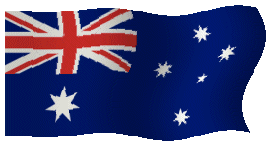
THE HOME WINE COURSE ©

Introduction:
Wines from the vast island/continent of Australia have become extremely popular in the United States over the last couple of decades. There's no great marketing marvel behind this fact; it's just that Australian wines are the ultimate in user-friendly drinkability. Rarely do you find an Australian wine that has rough tannic intensities. These wines are nearly always ripe and fruity, elegantly soft, mellow, and well-rounded by utilizing modern techniques like rotary fermentation and well-proven judicious barrel-aging. Another primary reason why wine enthusiasts love Australian wines is their wonderful affordability. Australia ranks with South Africa, Argentina, and Chile in this regard. However Australian wine production is lower than all the other southern hemisphere countries (except New Zealand) partly because Australia is the southern hemisphere's youngest wine industry (established early in the 19th century). Fortified wines dominated the Australian wine market until about thirty years ago when the switch to premium varietals became paramount. Now Australian premium wines are winning awards in wine shows worldwide. Penfold's Grange Hermitage Shiraz is perhaps the best known of Australia's first-class wines.
Levels of Quality
The Australian government has not established a controlled appellation system as is done in most of the wine-producing countries of Europe. Therefore it is important to know the reputation of Australia's various producers to have an idea regarding what level of quality you may be getting. The curious Aussie practice of labeling particular wines according to a bin number is fading (although Penfolds has a cult following for their various bin-numbered reds). As is true worldwide, Australian small production, estate-bottled wines are usually the finest followed by quality-minded large producers with vast resources who are able to blend wines of various districts for a uniformly satisfying taste. These large companies include such giants in Australian winemaking as Penfolds, Lindemans, Seppelt, Orlando, Yalumba, and Wynn's. Designations such as Reserve, Show Reserve, or Family Reserve are utilized occasionally and while not an official guarantee of quality usually indicate a special wine.
Grape Types
Until the premium wine revolution in Australia, the Sultana (Thompson's Seedless) grape reined supreme and was used for everything from table wines and fortified wines to raisins. However, as quality wines were more in demand other varietals quickly gained precedence. First and foremost of the reds is the Shiraz (Syrah in France and elsewhere). Old plantings of this Cote du Rhone varietal produce some of Australia's most monumental reds (including the Grange Hermitage). The difference from France's famous Syrah wines (Hermitage and Cote Rotie) is that Australian Shiraz is normally very soft and ripe with very mild tannins. Next in importance is the Cabernet Sauvignon which is increasing in acreage yearly. Cabernet Sauvignon is quite often blended with Shiraz by Australian vintners with great success; the earthy, herbal nuances of the Shiraz marrying nicely with the cassis-like fruit of the Cabernet. Merlot is also gaining in acreage due to its phenomenal popularity, as is Pinot Noir. Other red varietals like Cabernet Franc, Malbec, Grenache, Mourvedre, Cinsault, and even Zinfandel are utilized to varying degrees for blending purposes. Aussies prefer their white wines to reds so the greatest proportion of Australian wine production is with white varietals. Chardonnay has become the darling of Australian vignerons. The wine is generously-textured (mouth-filling) with intense apple, pear, and often tropical fruit aromas and flavors. New oak adds a welcome degree of sweet vanillin and toastiness. Semillon is often blended with Chardonnay, adding its citrus and herbal essences. Rhine Riesling (Johannisberg Riesling) is normally fashioned into a tasty peach and apricot-flavored dry white. Australia can also boast of having the largest planting of Marsanne outside of France. Other white varietals include the Trebbiano, Chenin Blanc, Verdelho, and Lexia (Muscat).
Regions of Production
Most of Australia's fine wines come from the cooler southern portions of the provinces of South Australia (60% of volume), New South Wales (23%), and Victoria (13%) all within the southeastern quadrant of the continent. Much smaller vineyard areas can be found in Western Australia around Perth (2%) and on the southern island of Tasmania. Viticultural districts are widely dispersed in the large southeastern provinces making regional appellation identification more difficult to follow. The most notable vineyard areas include the Clare Valley, the Barossa Valley, the McLaren Vale, Coonawarra, and Riverland on the Murray River (South Australia, near Adelaide); the Yarra Val, Goulburn Valley, and Geelong District (Victoria, near Melbourne); the Hunter Valley, Upper Hunter, and Mudgee Valley (New South Wales, near Sydney) and the Margaret River (Western Australia). Ninety percent of all Australian vineyards are located in this area of the country.
Summary
As we've mentioned earlier Australian wines are richly-flavored and easy-to-like in style. This makes them (even the reds) an ideal choice for before-dinner cocktail wines. The fruitier styles (red and white) work wonderfully well with the more piquant cheeses and spicy foods while the wood-aged, drier whites and reds are a perfect match for more savory meats and grilled or smoked foods in general. Late-harvest dessert wines (usually from the Rhine Riesling or Semillon grape) called stickies by the Aussies are also available and make a fine alternative to more expensive German beerenauslesen wines or French Sauternes.
Tasting Notes:
Top
Australia Map
Australia Review